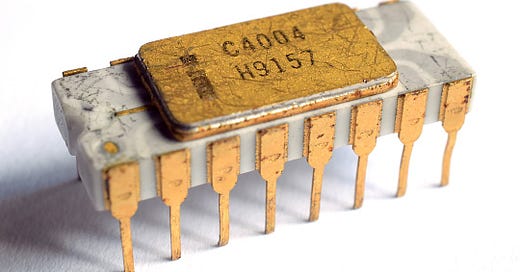Little Power In A Small, Cheap Package
How cost defined the 4004 and how Intel started to disrupt the computer industry.
We’ve covered the background to the development of the 4004. So what did the groundbreaking chip look like?
There is a photo of one version of the 4004 at the top of this post.
The defining characteristic of the 4004 was the number of metallic pins, used to carry electrical signals to the rest of the computer. In this photo, you can see eight, with eight hidden away on the other side of the chip.
With so few pins some had to perform more than one role. In particular, four were used to read ‘instructions’ from memory and to send or receive data from memory.
Except it was more complex than that. To read that instruction the 4004 had to specify a location (or ‘address’) in memory. The address would be twelve bits (a binary one or zero) long. So with four pins it would take three separate steps to specify the address.
The instruction would be eight bits long, which would take two more steps. The 4004 then had to perform or ‘execute’ the instruction which would take at least three more steps.
So performing the most basic instruction would take at least eight steps. Most of which were spent squeezing the data needed to communicate with the rest of the computer through those four pins.
The result was a chip that, compared to computers of the time and microprocessors that would follow, the 4004 would be excruciatingly slow.
Intel’s management had a phobia about increasing the number of pins. Dr Faggin would later say that Intel “threw away at least three times the performance” by limiting the chip to sixteen pins.
But this is missing the point. The 4004 was designed to be cheap to manufacture. In that, it succeeded magnificently. The contract with Busicom specified that Intel would charge $19.50 for each 4004. A complete set of chips with memory would cost around $70.
The popular mini-computer of the time, the DEC PDP-11/20, cost around $10,800 in 1969. On performance, the 4004 couldn't compete with the 11/20. Its price, though, meant it could be used where a mini-computer couldn’t.
It would be the start of a decades-long process where Intel would disrupt the entire computer industry.
Photo Credits
Intel 4004
By Thomas Nguyen - Own work
CC BY-SA 4.0, https://commons.wikimedia.org/w/index.php?curid=47684767




